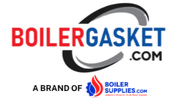The Complete Guide to Boiler Gaskets and Sealing Materials

Gaskets may seem like a minor component in your boiler system, but they are essential to ensuring your system operates properly. Below, we’ll break down what role gaskets play in a boiler system, the most common gasket materials and their ideal applications, and when to replace gaskets for best results.
What a Gasket Does in a Boiler System
Gaskets create a tight, reliable seal between metal surfaces, preventing steam, water, and heat from escaping the system. This is critical for maintaining boiler efficiency and ensuring facility safety.
When steam leaks occur, systems lose pressure and, thus, temperature. This forces the system to work harder with less efficiency, which costs facilities in terms of energy loss and increased maintenance. According to Inveno Engineering, a 1/8-inch steam leak at 100 psi can waste around 41 lbs. of steam per hour, amounting to about $3,591 in energy losses annually.
In addition to energy waste, leaking flanges can cause safety issues for facility personnel. Hot condensate dripping from leaking flanges can cause burns, or in outdoor systems during harsh weather, condensate can leak onto walkways and freeze, creating slipping hazards.
Gasket Types, Materials & What Each Does Best
Not all gaskets are created equal. The right gasket depends on the space you need to seal and the operating conditions that the gasket must endure.
Handhole & Manhole Gaskets
These gaskets are used on access points for inspection and maintenance and are typically elliptical or obround in shape. The gasket shape should match the handhole or manhole plate to ensure a proper seal. If an obround gasket, for example, is forced onto an elliptical plate, small gaps between the plate and gasket will be present, increasing the chance of leaks.
Beyond shape, you will also need to consider material type. Below are some of the most common gaskets and their uses.
Topog-E Series 180 EPDM Rubber Gaskets
Specifically designed for standard, medium-pressure boiler applications, EPDM gaskets provide excellent endurance under typical service conditions.
· Temperature rating: Up to 380 °F
· Pressure rating: Up to 180 psi
Blue Max (Glass/Elastomer-Impregnated Tacky Cloth)
Engineered for high-pressure steam systems, these gaskets are optimized for critical boiler loops where leak prevention and operational safety are paramount, even under fluctuating loads.
· Temperature rating: Up to 500 °F
· Pressure rating: Up to 450 psi
Black Max (Exfoliated Graphite)
Built for extreme thermal and pressure environments, Black Max gaskets feature layered stainless-steel foil and graphite. Their robust construction and material formulation make them ideal for supercritical and ultra-supercritical boiler applications with rigorous operational demands.
· Temperature rating: –400 °F to 850°F (atmosphere); 1200 °F (steam)
· Pressure rating: Up to 2000 psi
Certified as FDA-compliant, White Max gaskets are suitable for clean steam applications, ensuring contaminant-free sealing and chemical resistance essential for pharmaceutical, food, and chemical industry boilers.
· Temperature rating: –450 °F to 500°F
· Pressure rating: Up to 3000 psi
Boiler Doors, Flue Stack Connections, & Other Flanges
Boiler doors and flanges are exposed to high temperatures, thermal expansion, and occasional misalignment, making heavy-duty gasketing materials critical. Below are some of the most common gasketing materials and their uses.
Fills in larger channels, grooves, and irregular spaces where a bulky material is necessary for the best seal.
Creates an even seal on wide, flat surfaces with tight tolerance fits. Best for smooth sealing faces.
Ceramic Fiber Insulation Strips
Used on wide sealing surfaces. Often combined with less-compressible rope on the opposite face to create a reinforced seal on boiler doors.
Features a compressible “bulb” with a flat tail for anchoring. Excellent for irregular door frames with limited bolt force but where bulk is needed for an effective seal.
Excellent compressibility for filling in the toughest flange imperfections. Ideal for challenging sealing applications.
Note: Industrial boiler ropes and tapes come in ceramic fiber or fiberglass material. Fiberglass is rated for temperatures up to 1000°F and is ideal for standard applications. Ceramic fiber is rated for 2300°F and should be used instead of fiberglass in high-heat areas or those subjected to direct flame.
Learn More About Boiler Tapes and Ropes Here
How to Choose the Right Gasket
Choosing the correct gasket starts with evaluating operating conditions and physical sealing surfaces.
Key Considerations:
- Temperature & Pressure Ratings:
Always match or exceed system operating conditions with a proper safety margin. - Flange Imperfections:
Older or warped flanges may require more forgiving gasketing (e.g., thicker tapes, ePTFE) to seal all leak paths effectively. - Shape & Fit:
Handhole and manhole gaskets must match plate shape (elliptical vs. obround) and plate size.
When to Replace Gaskets
Best practice: Replace gaskets every time the boiler is opened for routine inspection or maintenance, even if no leak is currently present. Preventative replacement reduces the risk of costly, unplanned shutdowns.
Additionally, anytime you open a boiler door or inspection port, replace the gasket. Never reuse old gaskets, as compression set and creep can prevent them from resealing properly.
Conclusion
From handhole gaskets like Black Max, White Max, and Blue Max, to high-temp ropes on boiler doors, each gasketing material has its place in ensuring optimal boiler performance. By selecting the right gasket for the right location—and replacing it on schedule—you can prevent costly shutdowns, ensure facility safety, and keep your system running at peak efficiency.
👉 Need the right gasket fast? Explore our full line of gasket solutions for manholes, handholes, boiler doors, controls, flanges, and more — in stock and ready to ship.
Disclaimer:
TubeBundle.com provides this information for general reference and promotional purposes only. It is not professional advice nor is it a substitute for professional advice, diagnosis, or service. While we strive to provide accurate and up-to-date information, we cannot guarantee that the content is free from errors, omissions, or inaccuracies. Always consult a licensed technician or refer to the official manufacturer specifications and documentation when addressing any issues with your boiler or related equipment.


